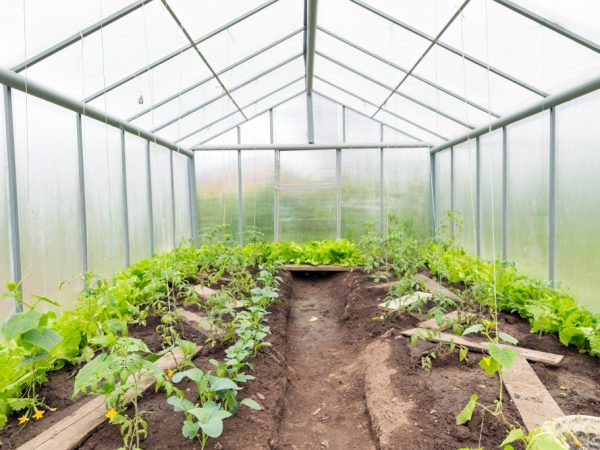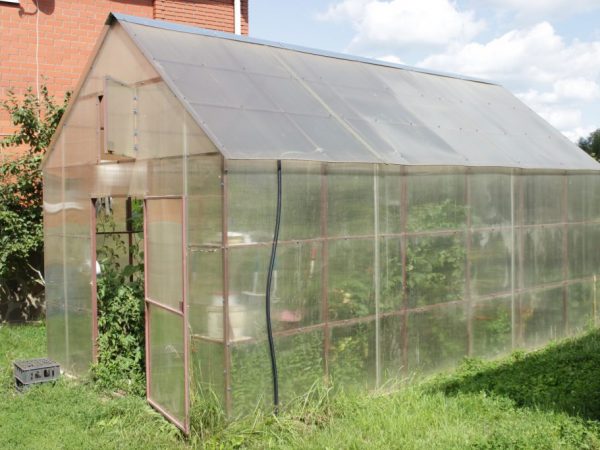Polycarbonate greenhouse for cucumbers
A polycarbonate greenhouse for cucumbers allows you to grow vegetables on your garden plot throughout the calendar year. In greenhouse conditions, conditions suitable for growing cucumber crops can be created so that cucumbers bear fruit from early spring to late autumn.

Polycarbonate greenhouse for cucumbers
The advantages of polycarbonate
A polycarbonate greenhouse for cucumbers, which is easy to make with your own hands, is very popular among summer residents due to the special technical characteristics of the material:
- polycarbonate sheets are quite reliable and withstand mechanical and physical loads, while maintaining the structural basis when a significant amount of snow accumulates on its surface, their maximum permissible level of load that the sheets can withstand ranges from 100 to 150 kg per 1 square meter, depending on on the density of the material,
- practical material does not require much maintenance, it is easy to install and, if necessary, to move to a new place, dismantle,
- sufficient durability and wear resistance of polycarbonate allows you to use a greenhouse for cucumbers for a long time, the service life of its operation reaches 20 years,
- a moisture-resistant surface does not allow unnecessary precipitation to pass through and does not react to climate change from the outside,
- the frost resistance of the greenhouse structure allows it to withstand low temperature conditions from the outside, maintaining the necessary microclimate for the cucumber outside.
Among the main advantages of using polycarbonate for greenhouses when growing vegetables is the fact that the material consisting of honeycombs evenly transmits solar heat.
How to choose polycarbonate
When choosing polycarbonate for the construction of a greenhouse, it is important to pay attention to some details:
- the most suitable polycarbonate sheet thickness for a greenhouse - from 4 to 8mm,
- sheets must be plastic, since in the manufacture of a polycarbonate greenhouse, in some cases they will have to be bent by hand in order to attach them to metal pipes - supports,
- the excessively low weight of a polycarbonate sheet is the reason why such a fragile material not intended for the construction of a greenhouse structure should be abandoned, the classic weight of a polycarbonate sheet measuring 2.1m * 6.0m is from 9 to 10kg.
Frame and roof of the greenhouse structure
When self-designed, a greenhouse frame is usually assembled from metal profiles, for which galvanized or metal arcs are suitable. Some people prefer to make a greenhouse frame from wooden pores, but we must not forget that this is not the best design, and the service life of a wooden frame is much shorter.
Base
Any greenhouse frame requires a base.At the same time, for metal structures, a concrete foundation is often poured at a depth below the freezing level of the soil. When assembling wooden frames, some are limited to wooden posts poured with concrete or metal pipes are concreted.
Cement (1kg), fine sand (2.5-3kg), gravel or broken stone (3-4kg) are suitable as a mixture for a reliable concrete base.
Installation on a wooden frame

Polycarbonate can cover wood frame
A do-it-yourself greenhouse frame made of wooden planks and boards is covered with paint or varnish before attaching polycarbonate to it, which prolongs its service life. The greenhouse structure is mounted according to the drawing with a drill, fastening the parts with dowels.
Mounting on a metal frame
Before covering the metal frame of the greenhouse, it is covered with anti-corrosion enamel. The parts are fastened together by welding, and the polycarbonate sheets are bolted.
Greenhouse roof
The roof can be single-pitched, gable or broken with many vents to provide the possibility of ventilating the greenhouse.
Mono-pitched
It is designed as an extension, for example, to the wall of a country house, placing the roof slope at an angle. The length of the roof is usually no more than 3.0-4.5 m, and the slope angle is calculated taking into account the climate of a particular region. A semi-truss acts as a supporting part for a pitched roof.
Gable
Such a greenhouse assumes that its roof consists of two parts (slopes), connected to each other at an angle of 24 'to 30'. The width of the gable roof is 30, -5.0 m, and the length can be different. Strength depends on the presence of a ridge connecting the slopes - the top of the roof.
Internal filling of the greenhouse
The creation of a favorable climate for growing cucumbers depends on the correct internal filling of the greenhouse structure.
Garden beds
The height of the beds for growing cucumbers is calculated based on the plant variety. A bed made high can also be filled with useful components to the maximum, and this will have a beneficial effect on early fruiting.
In the greenhouse, you can build beds, taking into account their use for cucumbers for at least 5-7 years, for which you need:
- dig a trench about 1.5 m wide and 1.5-2 shovels deep,
- lay tree branches and wood residues across the excavated earthen trench; for the first layer, birch, which has disinfecting properties, is a good material,
- the resulting voids will fill with sawdust,
- cover everything on top with a layer of straw 10 cm thick, on top of which lay paper or cardboard sheets,
- pour fresh plant waste left after processing plants on the paper covering, then - last year's half-ripe foliage,
- cover the last finishing layer with fresh compost mixed with garden soil.
So that such a bed structure does not crumble, support walls are installed for it in the form of wooden boxes or sheets of slate.
Growing tips
The advice of experienced gardeners who have adapted to growing cucumbers in a greenhouse and polycarbonate recommend not making a mini-borage, but erecting a structure no less than the height of the owner himself. This height will provide easy and complete care of the grown plants, provide them with enough space and fresh air.
The height of the greenhouse should be at least 1.8-2.0 m, width - from 2-4 m and wider. To facilitate the care of plants inside the greenhouse, I make paths.
If there are no opening vents in the greenhouse structure, too high a thermal regime will be created inside the room, leading to diseases and wilting of cucumbers. If you resort to frequent watering in such cases, you can achieve rotting of cucumber bushes. However, excessive ventilation of a greenhouse with drafts is also not welcomed by a vegetable crop.


